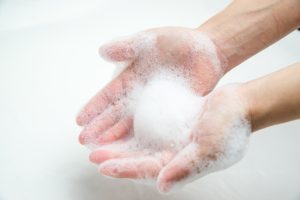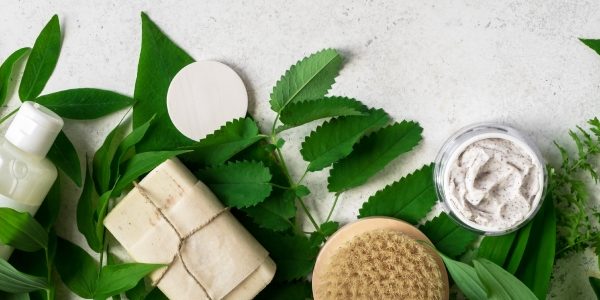As incontinence is often still a taboo subject, it is commonly just thought of as the constant changing of products. However, another huge aspect of managing incontinence is keeping the skin healthy.
Maintenance of healthy skin is a huge challenge for both incontinent individuals and their carers. As clinical research specialist, James B. Lutz states, “incontinence is associated with considerable morbidity as it predisposes individuals to perineal rashes, pressure sores, indwelling catheters, urinary tract infections and urosepsis.” He continues, “to the patient it represents considerable embarrassment and frequently leads to self-isolation and depression.” Initiatives such as the NHS Safety Thermometer now identify maintaining skin integrity as one of the key factors to reducing patient harm.

How can Incontinence cause serious skin damage?
A combination of factors that incontinent individuals are exposed to can cause them to become susceptible to serious skin conditions. One of these factors is the exposure to excessive moisture. This moisture, obtained from urine, sweat and frequent washings can increase the skin’s coefficient friction. This increase of friction causes the skin to become susceptible to rubbing and chafing against diapers, clothing and bed linens. Excessive skin moisture causes the skin to become more permeable to chemical irritants and provides an excellent medium for microbial growth. As moisture increases the skin’s vulnerability to mechanical forces, even the most gentle washing techniques are a significant source of irritation. Moist skin is permeable to chemical irritants contained in some products such as traditional soaps. Increased permeability caused by overhydration makes the skin of incontinent patients very susceptible to enzymatic, chemical and physical irritation. When skin is overhydrated, the epidermis is also more prone to injury from friction, caused by contact with clothing, incontinence pads or bed linen. When skin becomes constantly exposed to moisture, it can begin to break down and become unhealthy.
The combination of stool and urine can cause huge problems for the skin. When urine and stool mix, bacteria in the stool convert urea in the urine to ammonia. This combination of ammonia and stool can cause a dramatic shift in the PH of both the skin and the stool into the alkaline range. Not only is the skin now at a higher PH and more permeable to irritants, but the digestive enzymes in the stool attack the skin. The elevation of skin PH by ammonia strips away the skin’s protective mantle. Stool predisposes exposed skin to IAD through the presence of digestive enzymes that break down proteins and fats, critical elements of the skin’s moisture barrier. Just like stool, urea and urine can also affect the slightly acidic pH balance of the skin, causing it to become too alkaline. For those with faecal incontinence, therefore, the faeces contain harmful enzymes that break down the skin’s barrier, allowing bacterial and fungal growth. Perspiration can also add to the risk of irritation and painful skin breakdown. Constant exposure to urine and faeces can also cause symptoms such as redness, irritation and soreness. This can be both uncomfortable and socially isolating. Skin areas most affected are around the buttocks, hips, genitals and near the pelvis and rectum. Excess moisture in these areas makes skin problems such as yeast infections likely.
Surprising statistics about incontinence-associated skin damage:
- Incontinence Associated Dermatitis has been estimated to occur in 7% to 11% of incontinent nursing home residents
- Faecal incontinence increases the incidence of pressure ulcers more than 20 times
- Urinary incontinence increases the incidence of pressure ulcers more than five times
Incontinence Associated Dermatitis
Incontinence Associated Dermatitis is a prevalent complication of incontinence that compromises skin integrity and increases the risk of pressure ulcers developing. This causes a severe loss of independence and puts patients at high risk for pressure ulceration as well as increased risk of secondary infection morbidity. In two recent large studies of older individuals residing in long-term care facilities, 30% of all residents were found to have IAD. Clinical experience suggests that skin damage tends to originate as inflammation of the skin, seen as bright erythema in people with lighter skin tones and subtle redness in people with darker skin tones. Inflammation tends to follow areas of skin exposed to urine or stool and often involves the perianal area, buttocks, perineal and perigenital area and the inner thighs. Erosion of the epidermal and dermal layers of the skin occurs in more severe cases. This often begins as patches of denuded skin with serious exudate. According to the Journal of Aging Life Care, prevention of Incontinence-Associated Dermatitis is based on two principles: avoiding contact between urine or stool on the skin and providing a structured skin care regime that protects the skin from the damaging effects of incontinence.
Choosing the Correct Products
As soap and water are often readily available, it is common for people to turn to traditional soap and water methods for cleansing. However, frequent cleansing with soap and water can disrupt the skin’s integrity and reduce its ability to prevent infection. Most people are not aware that soaps actually contain cleansing ingredients called surfactants that can cause irritation if left on the skin. True soaps and alkyl sulfates tend to be harsh to the skin and can be very irritating. A study by researcher James B. Lutz comparing different skin products found that the elevation of skin PH by alkaline bar soaps can strip away the protective acid mantel of the skin. This acid mantel is a natural defence mechanism of the skin to help keep microbial growth in check. A program of gentle cleansing and moisturising can help maintain skin integrity. Liquid cleansers designed for continence care tend to be gentler than bar soaps, as they are formulated with gentle surfactants. You should avoid products that contain sodium lauryl sulfate, as this is a harsh alkyl sulfate surfactant.

A structured skin care regime should ideally be compromised of three essential elements: cleansing the skin, application of a moisturizer and application of a skin protectant. You should select a cleanser that mimics the skin’s PH, which varies from 5.5-5.9. Ensure you cleanse using gentle motions along with a soft, reusable or disposable washcloth to minimize epidermal damage caused by the friction of vigorous washing. Application of a moisturizing agent is recommended as it replaces intracellular lipids and aids the moisture barrier function of damaged or inflamed skin. Moisturizers on the market contain several classes of products including emollients containing lipids or oil that attract water to the skin.

Creams or ointments that contain zinc oxide, lanolin, or petrolatum form a protective barrier on the skin. By using a barrier cream or film, you can create a waterproof barrier between the skin and other substances. Some incontinence skin care products, often in the form of a spray or a towelette, create a clear, protective film over the skin. A provider can recommend barrier creams to help protect the skin.
If you are using a wheelchair or looking after someone who is using a wheelchair, it is important to check for pressure sores every day. With a bedridden incontinent person, you should make sure they change position frequently. When they are soiled, you should ensure you change sheets straight away. If you do find a pressure sore, you can invest in pressure reducing products such as pillows or foam padding.
Key Points in this Blog Post:
- Individuals with incontinence are more at risk of developing pressure ulcers, enzymatic, chemical and physical irritation
- Frequent cleansing with soap and water can disrupt the skin’s integrity and reduce its ability to prevent infection
- Incontinence Associated Dermatitis is caused by frequent exposure to urine and faeces
- A program of gentle cleansing and moisturising can help maintain skin integrity

Originally posted 2018-01-03 09:31:46.












Leave a Reply